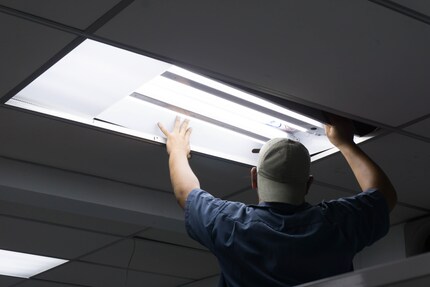
Company news
Our carbon crash diet: time to shed half the weight
by Tobias Billeter

Cloud computing, efficiency measures and the switch to renewable energy sources have significantly reduced our greenhouse gas emissions. We’ve pulled the plug on «dirty» electricity. Getting away from fossil fuels, on the other hand, will take time.
To reduce our greenhouse gas emissions by 50% within the next ten years, we need to put a lid on the biggest polluters. At Digitec Galaxus, the main sources of greenhouse gases are packaging, heating and electricity. This was revealed by a carbon footprint calculation first carried out in 2019. Reducing greenhouse gas emissions is particularly challenging because we’ve hugely expanded our business activities in recent years and grown massively internationally. Our workforce today has virtually doubled since 2019. This, of course, has also required more office and storage space – a development that’s clearly reflected in our energy footprint. Be as it may, there’s no way around reducing our company’s greenhouse gas emissions.
Reducing greenhouse gas emissions via electricity is relatively easy. We’ve taken three effective measures to rapidly reduce our footprint. Firstly, we obtain 100 per cent of our electricity from renewable sources – from domestic production wherever possible. Two years ago, we switched to hydroelectric and solar power with all our energy suppliers. The only exception being our site in Serbia, for which we haven’t been able to find a clean solution yet. Belgrade’s electric power company currently doesn’t offer green power. Until that changes, we’re offsetting our energy consumption by purchasing certificates.

Secondly, we migrated all servers from their previous data centres to the cloud. That’s all well and good, but what’s the point, some people might be thinking. In fact, the numbers are impressive. The efficiency gained with the cloud over locally operated data centres is huge. Studies show that the cloud consumes around 93 per cent less electricity and emits 98 per cent fewer greenhouse gases than conventional data centres to produce the same computing power. Migrating our IT infrastructure to the cloud has contributed hugely towards reaching our climate goals. In addition, our cloud service providers have committed to providing all services CO₂ emission free by 2030 at the latest.
Less is more!
Tweaking our existing building infrastructure can also be done quite easily. An analysis of the power consumption in our offices and warehouses shows that we can significantly reduce it without any noticeable restrictions. This can be achieved by fully switching to LED bulbs and introducing an intelligent lighting control system. The savings potential amounts to 5 to 10 per cent of the total amount of energy used. We've already made the switch in several buildings. Lighting efficiency is improved with the help of motion detectors and timers. The transition will be completed in all our buildings by the end of 2022. If we can also get Digitec Galaxus employees to consistently turn off their computers and monitors and switch off unnecessary light sources when they leave work, the next bill from Zurich’s electricity company (EWZ) should be 20 to 30 per cent lower.

Unfortunately, things won’t be moving as quickly when it comes to climate-friendly heat production. Making the switch with the heating infrastructure is cost-intensive, lengthy and dependent on external factors. Our headquarters in Zurich, for example, are connected to the city’s district heating network. Although this makes sense in terms of efficiency, district heating, which relies mainly on burning waste to produce heat, produces significant amounts of greenhouse gas emissions. This is because copious amounts of natural gas are burned together with the waste – a method that’s far from carbon neutral. The logistics halls we rent in Wohlen as well as the sales surfaces of our ten stores are also connected to existing oil, gas or district heating systems. Hooking these up to renewable energy sources is a slow process and needs to be done in close coordination with the landowners. Particularly in view of the investment cycles, completely cutting the cord to fossil heat generation is therefore likely to take some time.
In other words, there are many challenges to face when it comes to generating heat. Therefore, it’s essential that we fully tap into the existing savings potential to bridge the time until the switch to carbon-neutral solutions. With this in mind, we’ve reduced the room temperature in our offices, stores and warehouses by one to three degrees. Although this might not sound like much, it has a major effect. With every degree of room temperature saved, power consumption and with it greenhouse gas emissions drop by an impressive 6 per cent. Even though some employees were spotted wearing cardigans and wrapped in scarves as early as September, one thing remains clear, even now we’ve hit November. Not even the most thermo-sensitive staff members would be willing to go back on these vital energy-saving measures.
*As suspected, the calculated impact of our marketing activities was incorrect. We’ll be addressing this in the upcoming 2021 climate footprint report.
Making sure employees and media know what's up at Digitec Galaxus is my job. But without fresh air and a lot of exercise, I basically stop functioning. The great outdoors provides me with the energy I need to stay on the ball. Jazz gives me the tranquility to tame my kids.
Everything you'd usually read on a news portal or in the newspaper can be found here, directly from the source: annual figures, new services, our efforts for greater sustainability, sales trends and so on.
Show all